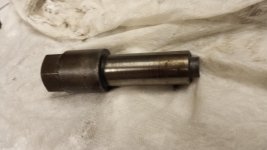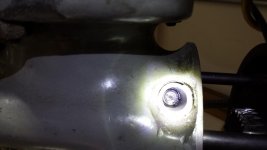jorsborn
Plastic
- Joined
- Sep 6, 2014
- Location
- Costa Mesa, CA United States
I recently bought a Bridgeport mill and am having a few issues. As you'll discern, I don't know what I am doing. I am not a machinist. I just (now) own a machine  . So, here it goes:
. So, here it goes:
1) I can't tram the head because it appears that the worm may be broken where that adjustment is made. Looking at an exploded parts diagram it appears to be a rather simple replacement if it weren't for the weight of the head. I was thinking of a way I could pull it off to investigate. I started welding up a fixture which I could secure to the table and insert into the quill using a collet. I am thinking that alone would probably stress the bearings too much so I was also thinking I could I could take the load off by using a few straps and my forklift.
2) Most important is all the slop I see in my table. When the table is all the way to one end or the other I don't see the slop. However, when the table is in the middle and I move it in your out (Y axis) the whole table cocks and based on what I measure, moves about .010 in the X direction when it does. This is really concerning because I fear that this might be an expensive fix. I also note that the table is very difficult to move around (X and Y). My point of reference is another friends Bridgeport which takes very little effort to move the table around.
Any thoughts on either issue? Any help is appreciated.
 . So, here it goes:
. So, here it goes:1) I can't tram the head because it appears that the worm may be broken where that adjustment is made. Looking at an exploded parts diagram it appears to be a rather simple replacement if it weren't for the weight of the head. I was thinking of a way I could pull it off to investigate. I started welding up a fixture which I could secure to the table and insert into the quill using a collet. I am thinking that alone would probably stress the bearings too much so I was also thinking I could I could take the load off by using a few straps and my forklift.
2) Most important is all the slop I see in my table. When the table is all the way to one end or the other I don't see the slop. However, when the table is in the middle and I move it in your out (Y axis) the whole table cocks and based on what I measure, moves about .010 in the X direction when it does. This is really concerning because I fear that this might be an expensive fix. I also note that the table is very difficult to move around (X and Y). My point of reference is another friends Bridgeport which takes very little effort to move the table around.
Any thoughts on either issue? Any help is appreciated.






